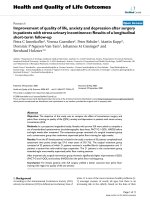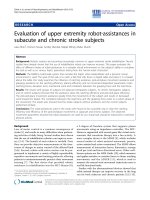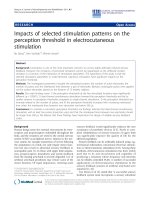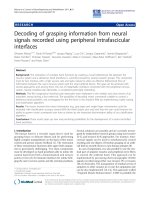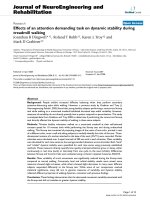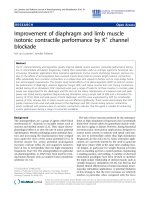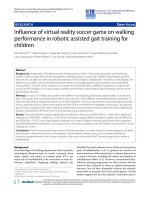Báo cáo hóa học: " Improvement of performance of InAs quantum dot solar cell by inserting thin AlAs layers" doc
Bạn đang xem bản rút gọn của tài liệu. Xem và tải ngay bản đầy đủ của tài liệu tại đây (440.95 KB, 5 trang )
NANO EXPRESS Open Access
Improvement of performance of InAs quantum
dot solar cell by inserting thin AlAs layers
Dongzhi Hu
1*
, Claiborne CO McPheeters
2
, Edward T Yu
2
, Daniel M Schaadt
1
Abstract
A new measure to enhance the performance of InAs quantum dot solar cell is proposed and measured. One
monolayer AlAs is deposited on top of InAs quantum dots (QDs) in multistack solar cells. The devices were
fabricated by molecular beam epitaxy. In situ annealing was intended to tune the QD density. A set of four
samples were compared: InAs QDs without in situ annealing with and without AlAs cap layer and InAs QDs in situ
annealed with and without AlAs cap layer. Atomic force microscopy measurements show that when in situ
annealing of QDs witho ut AlAs capping layers is investigated, holes and dashes are present on the device surface,
while capping with one monolayer AlAs improves the device surface. On unannealed samples, capping the QDs
with one monolayer of AlAs improves the spectral response, the open-circuit voltage and the fill factor. On
annealed samples, capping has little effect on the spectral response but reduces the short-circuit current, while
increasing the open-circuit voltage, the fill factor and power conversion efficiency.
Introduction
Group III-V compound semic onductor solar cells are the
highest efficiency cells developed to date [1] due to the
wide range of bandgaps that can be grown with high
crystalline quality in this material s ystem. Record effi-
ciencies around 40% [2] are achieved in triple junction
cells with an InGaP/InGaAs/Ge structure, in which lat-
tice-matched InGaAs replaces a middle GaAs layer. Due
to the three-dimensional confinement of quantum dots
(QDs), their incorporation into the middle layer enhances
the photo current of solar cells, which can be further
improved by forward scattering techniques [3]. The elec-
tronic properties of QDs depend on their siz e, shape, and
surrounding matrix [4] and can be tuned during molecu-
lar beam epitaxy (MBE) by growth rate, temperature, and
in situ annealing proc edures [5,6] . In particular, it is pos-
sible to tailor the absorption spectrum of the InAs QDs
to the 1.0 to 1.2 eV range, which allows for enhanced
absorption with respect to the solar spectrum. To tailor
the absor ption spectrum of the InAs QD, an in situ
annealing procedure is often used. Annealing of InAs
QDs at relatively low temperatures, i.e., lower than 470°C
right after their deposition leads to classical Ostwald
ripening. In this c ase, the dot density decreases with
smaller dots disappearing while larger dots growing with
annealing time. When the dot size becomes larger than a
critical value, dislocations are formed, which is not pre-
ferred for solar cells. However, when annealin g InAs
QDs at relatively high temperatures, i.e., higher than
490°C, a combination of ripening and InAs decomposi-
tion occurs. The size and chemical composition of QDs
can then be tuned without formation of defects [7]. For
enhancement of absorption, vertical stacks of InAs QDs
embedded in InGaAs/GaAs are preferred, where segrega-
tion of In has to be considered, espe cially with an in situ
annealing procedure [8]. To suppress this In segregation,
a thin AlAs capping layer can be introduced [9,10]. How-
ever, the effect of this thin AlAs layer on the device
performance is thus unclear and needs to be studied.
In this study, we fabricated GaAs-based p-i-n junctions
with a stack of 10 layers of InAs QDs as the intrinsic
layer. The density of the InAs QDs in e ach layer was
tuned by in situ annealing a t high temperature. To sup-
press In segregation and thereby keeping the InAs QD
composition approximately constant, one monolayer
AlAs was deposited on top of the QD layer. The influ-
ence of capping the dots with a monolayer of AlAs
on devices with and without in situ annealed QDs is
investigated.
* Correspondence:
1
Institut für Angewandte Physik/DFG-Center for Functional Nanostructures,
Karlsruhe Institute of Technology (KIT), Karlsruhe, Germany
Full list of author information is available at the end of the article
Hu et al. Nanoscale Research Letters 2011, 6:83
/>© 2011 Hu et al; licensee Springer. This is an Open Access article distri bute d under the terms of the Creative Commons Attribution
License ( which permits unrestricted use, distribution, and reproduction in any medium,
provided the or iginal work is properly cited.
Experimental
The solar cell structures are shown in Table 1. Before
growth of the structures, epi-ready Si-doped Ga As (100)
substrates were pre-degassed in a load lock chamber at
130°C for 1 h. Then the substrates were transferred into
the growth chamber and heated up to 600°C under As
4
ambient conditions to remove the oxide layer. In situ
refl ection high energy electron diffractio n (RHEE D) was
used to observe the surface reconstructions. When a
clear 2 × 4 reconstruction appeared, we decreased the
temperature to 570°C to start growth of a 1 μm thick n-
doped GaAs with a doping level of 7 × 10
18
cm
-3
. Then
10 stacks of 20 nm intrinsic GaAs, covered by InAs
QDs capped with a 6.6 nm thin In
0.12
Ga
0.88
As layer,
were deposited. For the InAs QDs layers, we deposited
nominally 2.3 monolayers, which correspond to 0.69 nm
thick. Since the InAs QDs are formed in the Stranski-
Krastanov growth mode, this leads to a wetting layer of
about 1.6 monolayer thickness and the QDs on top of
it. For devices with in situ annealed QDs, the growth
was interrupted right after deposition of each of the
InAs QDs for 5 min. The temperature was kept at the
growth temper ature, thereby allowing for In surfac e dif-
fus ion and desorption, resulting in a combined rearran-
gement of the InAs QDs to a distribution with lower
dot density and lower In c ontent [7]. For device s with
AlAs capping, one monolayer (0.283 nm) of AlAs wa s
deposited on top of the QDs befor e covering them with
the 6.6 nm thick In
0.12
Ga
0.88
As layer. At the end a
20 nm thick intrinsic GaAs layer followed by a 100 nm
thick p-doped GaAs of 1 × 10
19
cm
-3
was deposited. Sili-
con and Beryllium were used as n- and p-type dopants.
During growth, the equivalent beam pressure of As
4
remained at 3.0 × 10
-6
Torr and equivalent beam pres-
sure of Ga, In, and Al were 4.67 × 10
-7
Torr, 2.0 × 10
-8
Torr, and 1.2 × 10
-8
Torr, respectively. The temperature
was calibrated by a pyrometer. The growth rates were
calibrated by RHEED specular spot oscillations. In total,
we fabricated four types of samples: sample A contains
unannealed QDs without AlAs capping. Sample B
contains unannealed QDs with AlAs capping. Samples C
and D contain a nnealed QDs without and with AlAs
capping, respectively. In ord er to distinguish the differ-
ence of these four types of samples, they are summar-
ized in Table 2. The morphology of the device surface
was measured by atomic force microscopy (AFM) in
contact mode. Devices were il luminated with a Newport
Oriel 96000 solar simulator operating at 160 W while
device performance was measured with a Hewlett-
Packard 4156A analyzer. More details on fabrica tion of
contacts and photocurrent measurements are given else-
where [11].
Results and discussion
Figure 1 shows AFM images of all four samples. The
surface of samples A and B a ppears s imilar. For sample
A, the RMS roughness is 1.12 nm over an area of 10 ×
10 μm
2
. It is slightly better than the RMS roughness of
sample B, which is 1. 16 nm for an area of 10 × 10 μm
2
.
FromtheAFMimageofsampleC,whichcontains
annealed InAs QD layers, dashes and holes are clearly
visible. The holes are anisotropic with the dashes run-
ning perpendicular to the elongated directions of the
holes. However, AFM images of sample D, which con-
sists annealed QDs covered by 1 ML AlAs, show that a
much lower density of holes is present and the dashes
are barely visible compared to sample C. The scale bars
of AFM images of sample C and D indicate that the
holes are much deeper on sample C than the ones on
sample D, although the scales do not show the real
values due to the limitation of the AFM tip. The appear-
ance of holes and dashes on sample C can be exp lained
as a result of decomposition of InAs, In segregation and
In-Ga intermixing [7], as well as Ga(In) migration aniso-
tropically along the [1-10] and [110] direction during
the in situ annealing procedure [12]. These processes
lead to a roughening of the surface which accumulates
after 10 periods of annealed QDs. These effects are
however suppressed or strongly reduced b y inclusion of
the AlAs capping layer, as seen in sample D. E special ly
the formation of holes could be explained as same as
the formation of nanostructures by droplet epitaxy [13].
Figure 2a shows the room temperature p hotocurrent
spectra of samples A and B. The response peak of QD
layer from sample A is at longer wavelength comparing
to the response peak of sample B. This is consistent
with the studies of Suzuki et al. [14]. The intermixing of
InAs with GaAs can b e suppressed by inserting a thin
AlAs layer between InAs and GaAs. Therefore, the
response wavelength from QDs covered by AlAs blue-
shifts compared to the response wavelength of the sam-
ple without AlAs layers. The same occurs for the
devices with annealed QDs, i.e., for samples C and D, as
shown in Figure 3a.
Table 1 Layer structures for samples without and with
AlAs capping
Without AlAs capping With AlAs capping
100 nm p-GaAs 100 nm p-GaAs
20 nm i-GaAs 20 nm i-GaAs
6.6 nm i-InGaAs 6.6 nm i-InGaAs
InAs QDs 10× 0.283 nm AlAs 10×
InAs QDs
20 nm i-GaAs 20 nm i-GaAs
1 μm n-GaAs buffer 1 μm n-GaAs buffer
n-GaAs substrate n-GaAs substrate
Hu et al. Nanoscale Research Letters 2011, 6:83
/>Page 2 of 5
The curves of current density versus voltage (J-V)of
samples A and B are shown in Figure 2b, while those
forsamplesCandDareshowninFigure3b.Thefill
factors, illumination short-circuit current densities (J
sc
),
open-circuit voltages (V
oc
), and maximum power density
(V
M
J
M
) are summarized in Table 3. The fill factor is cal-
culated according to the equation:
FF = ()/( ).VJ V J
MM OCSC
J
sc
for all the samples are similar except for sample C.
As seen from the AFM images in Figure 1, sample C
has deep holes on the surface. Their effect on the device
performance is thus f ar unclear and is currently under
investigation. From Table 3, one can see that the open-
circuitvoltagesofthesamples(samplesAandB)with
as-grown InAs QDs have higher values. Also, for the
samples with one monolayer AlAs layers (samples B and
D), the open-circui t voltage s are improved compared to
samples without one monolayer AlAs capping layers
(samples A and C). Looking at the fill factors and open-
circuit voltages, o ne can conclude that both quantities
are higher for samples with AlAs layers than those of
samples without AlAs layers, no matter with as-grown
QDs or with annealed QDs. The reason for improve-
ment of open-circuit voltages and fill factors in samples
with a thin AlAs layer is currently under investigation.
Furthermore, by calculation of the power conversion
efficiency (h) with the equation:
= VJ PP
MM
/( ),is the illumination power density
we can conclude that wit h thin AlAs layers, the effi-
ciency is enhanced by 6.15 and 2.75% for the devices
with as-grown QDs and annealed QDs, respectively.
Comparing Figures 2 and 3, one can see that the solar
response spectra of samples C and D w ith annealed
QDs a re blue-shifted compared to those for samples A
and B. The photo curre nts and open-circuit voltages of
these samples with annealed QDs decrease. The blue-
shift of the solar response spectra is probably due to the
change of InAs composition, which decreases during
annealing [7]. T he decrease of photo currents can be
related to the lower QD density due to in situ annealing.
A detailed explanation for this decrease in QD density
Table 2 Four types of samples
Sample A Sample B Sample C Sample D
With InAs QD layers As grown As grown Annealed for 5 min Annealed for 5 min
QDs are covered by 1 ML AlAs layers No Yes No Yes
Figure 1 AFM images of device surfaces. (a) With as-grown InAs
QDs and without AlAs layers (sample A), (b) with as-grown InAs QDs
and AlAs layers (sample B), (c) with annealed InAs QDs and without
AlAs layers (sample C), and (d) with annealed InAs QDs and AlAs
layers (sample D).
Figure 2 Photocurrent spectra and current density-voltage (J-
V) curves of devices with as-grown QDs with (sample A) and
without AlAs capping layers (sample B). (a) Photo-current spectra
and (b) J-V curves.
Hu et al. Nanoscale Research Letters 2011, 6:83
/>Page 3 of 5
during in situ annealing can be found in [7]. The holes
and dashes are most likely the major reason for lower
open-circuit voltage of the device with annealed QDs.
Conclusions
GaAs-based p-i-n solar cells with a multistack of InAs
QD em bedded in InGaAs/Ga As matrix were fabricated
by MBE. Post-growth annealing was used to tune the
InAs QDs density. Annealing of InAs QDs introduces
holes and dashes on the device surface and the solar
response spectrum is blue-shifted, while t he fill factor
decreases. With insertion of one mono layer AlAs cap-
ping on top of the annealed InAs QDs for each layer in
the st ack, the dashes on the surface disappear and the
density of holes decreases. The fill factors and power
conversion efficiency and open-circuit voltages are
improved, although the short-circuit current is reduced.
Abbreviations
AFM: atomic force microscopy; MBE: molecular beam epitaxy; QDs: quantum
dots; RHEED: reflection high energy electron diffraction.
Acknowledgements
The authors acknowledge financial support from the Deutsche
Forschungsgemeinschaft (DFG) through grant DFG SCHA 1576/1-1, the U.S.
National Science Foundation through Grant No. DMR 0806755, and the U.S.
Department of Energy through Grant No. DE-FG36-08GO18016. Part of this
study was also supported by DFG and the State of Baden-Württemberg
through the DFG-Center for Functional Nanostructures (CFN) within
subproject A2.6.
Author details
1
Institut für Angewandte Physik/DFG-Center for Functional Nanostructures,
Karlsruhe Institute of Technology (KIT), Karlsruhe, Germany
2
Department of
Electrical and Computer Engineering, Microelectronics Research Center,
University of Texas at Austin, Austin, TX 78758, USA
Authors’ contributions
DZH carried out growth of the devices and COMcP carried out electronic
characterization of the devices. ETY and DMS conceived of the study, and
participated in its design and coordination. All authors read and approved
the final manuscript.
Competing interests
The authors declare that they have no competing interests.
Received: 26 September 2010 Accepted: 12 January 2011
Published: 12 January 2011
References
1. Green MA, Emery K, Hishikawa Y, Warta W: Solar Cell Efficiency Tables
(Version 32). Prog Photovolt Res Appl 2008, 16:435.
2. King RR, Law DC, Edmondson KM, Fetzer CM, Kinsey GS, Yoon H, Sherif RA,
Karam NH: 40% efficient metamorphic GaInP/GaInAs/Ge multijunction
solar cells. Appl Phys Lett 2007, 90:183516.
3. McPheeters CO, Hill CJ, Lim SH, Derkacs D, Ting DZ, Yu ET: Improved
performance of In(Ga)As quantum dot solar cells via light scattering by
nanoparticles. J Appl Phys 2009, 106:056101.
4. Ngo CY, Yoon SF, Fan WJ, Chua SJ: Effects of size and shape on electronic
states of quantum dots. Phys Rev B 2006, 74:245331.
5. Ngo CY, Yoon SF, Fan WJ, Chua SJ: Tuning InAs quantum dots for high
areal density and wideband emission. Appl Phys Lett 2007, 90:113103.
6. Ngo CY, Yoon SF, Tong CZ, Loke WK, Chua SJ: An investigation of growth
temperature on the surface morphology and optical properties of 1.3
μm InAs/InGaAs/GaAs quantum dot structures. Nanotechnology 2007,
18:365708.
7. Hu DZ, Trampert A, Schaadt DM: Morphology and stress evolution of InAs
QD grown and annealed in-situ at high temperature. J Cryst Growth 2010,
312:447.
8. Moison JM, Guille C, Houzay F, Barthe F, Van Rompay M: Surface
segregation of third-column atoms in group III-V arsenide compounds:
Ternary alloys and heterostructures. Phys Rev B 1989, 40:6149.
9. Kawai T, Yonezu H, Ogasawara Y, Saito D, Pak K: Segregation and
interdiffusion of In atoms in GaAs/InAs/GaAs heterostructures. J Appl
Phys 1993, 74:1770.
10. Dorogan VG, Mazur YuI, Lee JH, Wang ZhM, Ware ME, Salamo GJ: Thermal
peculiarity of AlAs-capped InAs quantum dots in a GaAs matrix. J Appl
Phys 2008, 104:104303.
Figure 3 Photocurrent spectra and current density-voltage (J-
V) curves of the devices with annealed QDs with (sample C)
and without AlAs capping layers (sample D). (a) Photo-current
spectra and (b) J-V curves.
Table 3 Summary of short-circuit current density, open-
circuit voltage, fill factor, and maximum power density
for samples A (as-grown QDs without AlAs layer), B (as-
grown QDs with AlAs layer), C (annealed QDs without
AlAs layer), and D (annealed QDs with AlAs layer)
Sample
A
Sample
B
Sample
C
Sample
D
Short-circuit current density
(mA/cm
2
)
-5.65 -5.56 -7.00 -5.26
Open-circuit voltage (V) 0.617 0.642 0.475 0.540
Fill factor 0.671 0.696 0.524 0.631
Maximum power density
(V
M
J
M
)
2.340 2.484 1,743 1,791
Hu et al. Nanoscale Research Letters 2011, 6:83
/>Page 4 of 5
11. Yu ET, Derkacs D, Lim SH, Matheu P, Schadt DM: Plasmonic nanoparticle
scattering for enhanced performance of photovoltaic and photodetector
devices. Proc SPIE 2008, 7033:70331V.
12. Riotte M, Fohtung E, Grigoriev D, Minkevich AA, Slobodskyy T,
Schmidbauer M, Metzger TH, Hu DZ, Schaadt DM, Baumbach T: Lateral
ordering, strain, and morphology evolution of InGaAs/GaAs(001)
quantum dots due to high temperature postgrowth annealing. Appl Phys
Lett 2010, 96:083102.
13. Lee JH, Wang ZhM, Kim ES, Kim NY, Park SH, Salamo GJ: Various Quantum-
and Nano-Structures by III-V Droplet Epitaxy on GaAs Substrates.
Nanoscale Res Lett 2010, 5:308.
14. Yokota H, Iizuka K, Okamoto H, Suzuki T: AlAs coating for stacked
structure of self-assembled Inas/GaAs quantum dots. J Cryst Growth 2007,
301-302:825.
doi:10.1186/1556-276X-6-83
Cite this article as: Hu et al.: Improvement of performance of InAs
quantum dot solar cell by inserting thin AlAs layers. Nanoscale Research
Letters 2011 6:83.
Submit your manuscript to a
journal and benefi t from:
7 Convenient online submission
7 Rigorous peer review
7 Immediate publication on acceptance
7 Open access: articles freely available online
7 High visibility within the fi eld
7 Retaining the copyright to your article
Submit your next manuscript at 7 springeropen.com
Hu et al. Nanoscale Research Letters 2011, 6:83
/>Page 5 of 5
